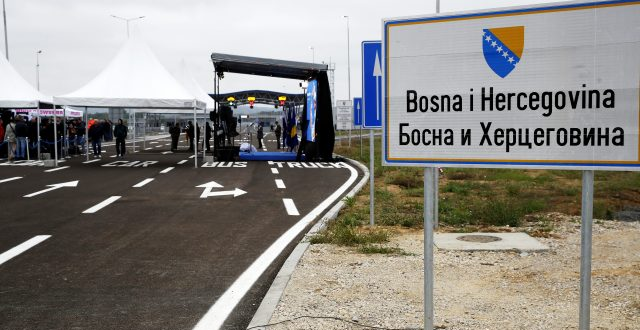Croatia says that a big jump in migrants and refugees being returned to Bosnia is thanks to Sarajevo finally implementing a bilateral ‘readmissions’ deal. Data from Bosnia suggests otherwise.
Croatia has been sending migrants and refugees back to Bosnia and Herzegovina since 2017 on the basis of a bilateral agreement between the ex-Yugoslav republics, data from Bosnia suggests, contradicting a claim by Croatia that its neighbour only began implementing the deal this year.
Hundreds have been returned since the end of March under a bilateral agreement signed in 2002 and updated in September 2011 but which Croatian authorities say was not actually put into use until this year.
Local authorities in northwestern Bosnia, bordering Croatia, have voiced alarm at the rise in returns, while human rights organisations and legal experts have questioned the legality of the so-called ‘readmissions’ process under European law and expressed concern at allegations of degrading treatment and rights violations by Croatian police.
Now, data provided to BIRN by Bosnia’s Foreigners Affairs Service, part of the security ministry, suggests that migrants and refugees have been returned to Bosnia on the basis of the deal since 2017 – contradicting Croatia’s claim that it only began this year – but that this year the numbers shot up.
According to the Service’s figures, 3,433 people have been ‘readmitted’ since 2017, the year that migrants and refugees mainly from the Middle East, Asia and Africa began crossing Bosnia in any great numbers. That does not include the thousands returned illegally, so-called ‘pushbacks’ across the border that fly in the face of the internationally-guaranteed right to seek asylum.
“The Readmission Agreement with Croatia was signed in 2011 and has been in effect since that date,” the security ministry told BIRN, but since the beginning of this year, “there has been an increase in Croatia’s requests for the acceptance of migrants who illegally cross from Bosnia and Herzegovina into Croatia.”
EU intervention
In the first three months of this year alone, according to the Bosnian data, Croatia sent back 1,068 migrants and refugees on the basis of the agreement. Between January 1 and April 19, Bosnian authorities refused to take a further 1,950, arguing that Croatia had failed to prove they entered from Bosnia.
Croatian authorities, however, say the rise in returns is simply due to the fact that Bosnia finally began implementing the readmissions agreement, after some prodding from the European Union.
“Namely, after six years Bosnia and Herzegovina began implementing the agreement that the Republic of Croatia and Bosnia and Herzegovina concluded, and which regulates the acceptance and return of individuals who illegally crossed the joint border,” the Croatian interior ministry told BIRN.
It said implementation had been discussed repeatedly and that, at a meeting in Brussels on March 28, “the European Commission reminded Bosnian authorities of their obligation to implement the agreement”.
Croatian authorities did not respond to requests for clarification concerning the number of migrants and refugees returned to Bosnia or how many have been sent to Croatia from other EU states.
‘I am worried’
Serbian human rights lawyer Nikola Kovacevic said that while readmission was “better” than pushback – “as it is a form of cooperation between the border authorities on surrendering people back not in a secret way, but in a way that can be assessed externally” – such agreements in the past, and particularly in the Balkans, saw people being returned from one country to another “without a proper assessment of the risks of refoulement which should be connected with the safe third country concept, or the safety of Bosnia and Herzegovina in this case.”
Bosnia has a similar such deal in place with Serbia, the security ministry told BIRN, but Bosnia returns to Serbia far fewer than Croatia returns to Bosnia.
According to the UNHCR, the principle of non-refoulement “prohibits countries from transferring or removing individuals from their jurisdiction or effective control when there are substantial grounds for believing that the person would be at risk of irreparable harm upon return”.
It is a principle that is included in the EU’s Charter of Fundamental Rights but which Europe has routinely disregarded in its response to the flow of refugees and migrants across its borders. The principle also sets limitations on such bilateral readmission agreements.
“If people are refugees, like in the case of Syrians and Afghans, Croatia should obtain guarantees from Bosnia and Herzegovina that these people will be allowed to access asylum procedures,” Kovacevic said. “The second thing that Croatia should have in mind is the effectiveness of [the] asylum system in Bosnia.”
Kovacevic argued that the state of the Bosnian asylum system means that sending a refugee back to Bosnia would be a violation of Article 3 of the European Convention on Human Rights.
According to the Bosnian data, Afghans fleeing renewed Taliban rule make up the largest national contingent of refugees and migrants on its territory, while Kovacevic cited data suggesting that between 60 and 70 per cent of migrants and refugees registered in the Western Balkans last year were from refugee-producing countries.
Yet Bosnia itself is also sending people back to their countries of origin – 1,904 based on various readmission agreements between 2018 and end-2022. The security ministry did not specify which countries.
“I cannot claim that [the readmissions procedure] is not in line with international law because I haven’t seen the case files and the way it has been conducted so far, but I am worried,” Kovacevic told BIRN.
 Eurasia Press & News
Eurasia Press & News



